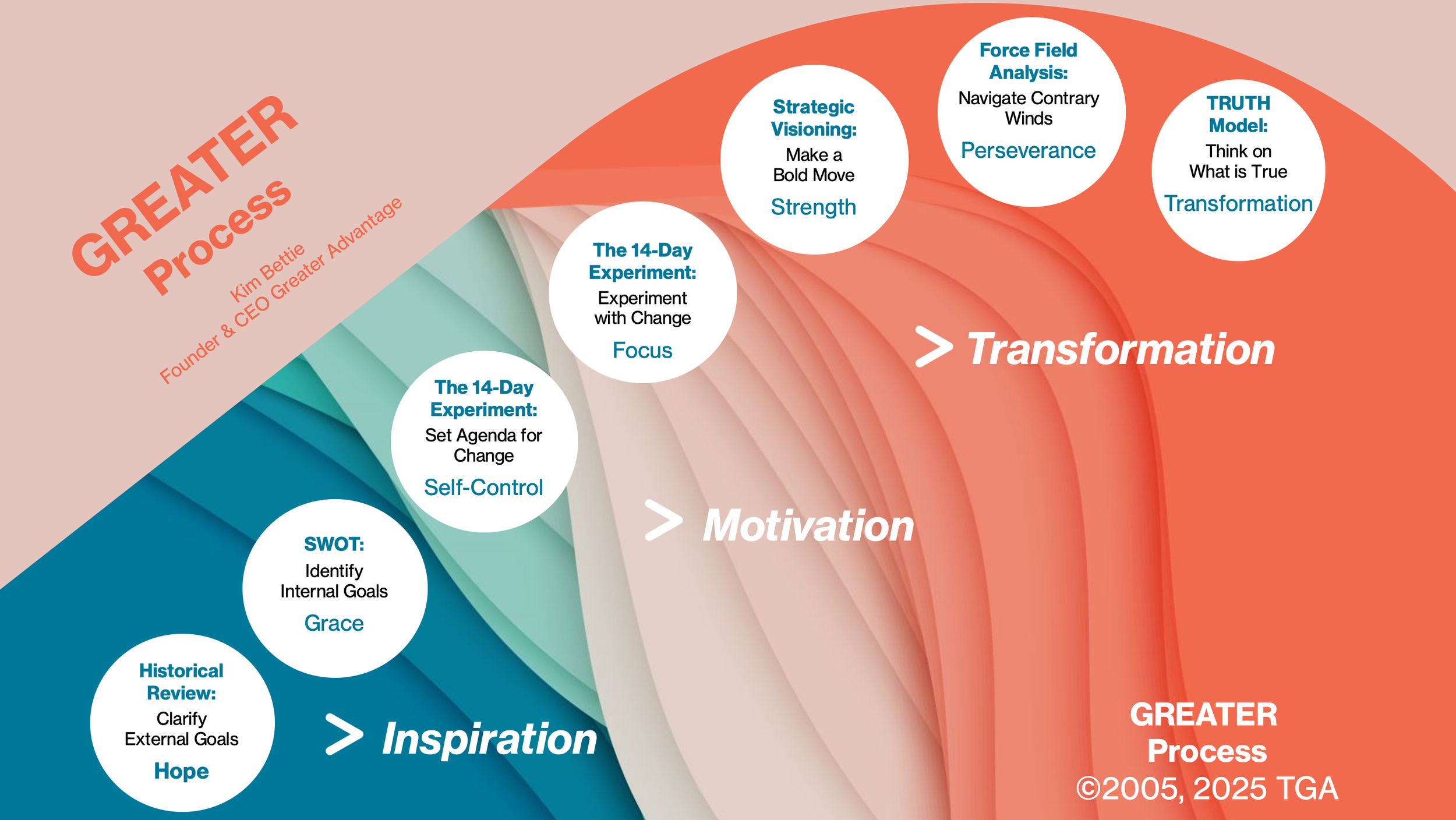“My mission is to take you on a journey to be, do and have greater.”
Greater Methodology and Process
Take a look at the two models below to get a glimpse of Greater methodology and coaching process.
The models below visually represents greater methodology and the greater coaching process for application, they also embody my experience working in both secular and faith-based settings. The models reflects the steps of development on my journey to being, doing, and having greater and the spirit-led scriptures that have become the foundation of my coaching style and process I use in a variety of settings.
In 2005, I piloted the methodology and process with a small group gathered around my kitchen table. Since then, countless individuals have fulfilled their calling and experienced personal breakthroughs using this approach. As you continue reading, you’ll see how this methodology serves as the driving force behind the greater coaching process that I developed and use to support purpose-driven individuals in achieving their personal and professional goals.
GREATER METHODOLOGY
G.R.E.A.T.E.R. Methodology Model
GREATER COACHING PROCESS
The greater coaching process aligns with the wellness wheel theory and focusing on seven key dimensions of well-being: spiritual, physical, financial, vocational, recreational, relational, and societal. By addressing these interconnected areas, the process promotes holistic transformation while preventing burnout, ensuring that growth is both sustainable and balanced. It is grounded in psychological insight, shaped by two decades of experience applying corporate strategies, and refined through structured coaching process. These tools are used with discernment—selected only when they align with biblical values and with the client’s expressed goals. This is not a “mix and match” approach, but a thoughtful integration that ensures clients grow with clarity, integrity, and faith.
The journey to greater includes three phases of transformation. Each phase empowers individuals by integrating personal reflection, experiential learning, and strategic thinking strategies.
Inspiration – The first phase sets begins with introspection and intentional goal-setting that inspires. In this phase, we assess internal motivations, strengths, and character development to establish a clear vision.
Motivation – This phase involves experimenting with actionable steps that motivate you to uncover root causes of setbacks. Through guided exercises, individuals gain deeper insight into limiting beliefs and untapped potential.
Transformation – The final phase focuses on developing a strategic plan that transforms previous pain and current passion into purpose. Here, you integrate strategies that sustains resilience, consistency, and long-term success.
Below, you’ll find testimonials from coaching clients on their journey to greater.
Faith integration isn’t an add-on—it’s the advantage.
I believe personal growth is most powerful when it’s spiritually aligned. That’s why I integrate faith into coaching in a way that is purposeful, respectful, and client-centered. Whether someone is seeking clarity in their calling, strength to move forward, or peace in the midst of opposition, I meet them where they are—spiritually and practically—and help them grow from there.
To ensure that faith is only included when it aligns with the client’s beliefs and preferences, I use a structured process to determine if, when, and how faith is integrated into the coaching experience. The model and details are below:
The ABCD Decision Model for Faith Integration is the foundation of how I ethically and intentionally incorporate faith into coaching. It helps ensure that the process is respectful, client-centered, and Spirit-led—while remaining grounded in coaching best practices. This model guides me through four key stages:
A – Alignment
I begin by clarifying the values and expectations of the coaching relationship, including any organizational or spiritual context. I also align myself with prayer and prepare to coach from a place of integrity, wisdom, and discernment.
B – Belief Awareness
Early in the coaching process, I invite the client to share their personal beliefs. Are they a person of faith? How does their faith influence their goals, values, or identity? This conversation helps us determine whether faith will be part of the coaching journey.
C – Consent to Integrate
If the client expresses interest in incorporating faith, we discuss what that might look like. Do they want to pray, use Scripture, reflect on spiritual experiences, or simply be coached by someone who understands their worldview? Faith is only integrated with full, informed consent.
D – Delivery of Coaching Tools and Faith Practices
Based on the client’s invitation, I deliver coaching that integrates biblically aligned tools and practices—or other spiritually meaningful elements that align with the client’s faith tradition. This may include purpose-based goal setting, mindset renewal, values clarification, prayer, Scripture meditation, or spiritual journaling.
I remain attuned to how faith and coaching strategy can work together to support the client’s transformation—always honoring their beliefs, boundaries, and goals. This approach creates space for clients of all faith backgrounds to grow in alignment with their purpose while being supported by a spiritually sensitive coach.
The Invitation to Recognize and Respond to Sacred Moments in Coaching.
In faith-integrated coaching, not every breakthrough is planned. Some moments feel sacred—unexpected pauses in the conversation where the client’s heart opens, clarity emerges, or the presence of God feels near. These are sacred moments are not manufactured or forced, but revealed in the flow of coaching when Spirit meets strategy.
As a coach, I listen not only with my training, but with spiritual discernment. I stay attentive to when a client expresses a deeper need—whether emotional, spiritual, or a moment of decision that invites divine wisdom.
Sacred moments often occur:
When a client hits a wall of fear or doubt
When a long-held belief is challenged or released
When the client expresses gratitude, grief, or surrender
When a goal becomes more than a task—it becomes a calling
When the client experiences a personal revelation or spiritual insight that reframes everything



